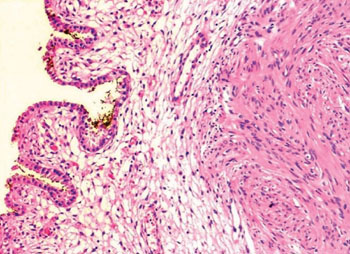Molecular Blood Test Helps Physicians Identify Benign Lung Nodules
By LabMedica International staff writers
Posted on 06 Jul 2015
Conservative management of lung nodules, sometimes referred to as watchful waiting, involves repeated computerized tomography (CT) scans over a two-year period to monitor the progress of patients whose nodules are initially deemed likely to be benign.Posted on 06 Jul 2015
If the clinician’s initial assessment of the patient's lung nodule is later found to be incorrect, then the cancers are usually discovered early in the follow up period and remain at an early enough stage for therapeutic intervention.

Image: Histopathology of a benign sub-pleural lung nodule showing spindle cell lesion morphology (Photo courtesy of Aga Khan University Hospital).
Scientist at the Medical University of South Carolina (Charleston, SC, USA) and their colleagues carried out a retrospective study of 377 patients and sought to describe how pulmonologists typically manage these patients in their standard practice and to estimate the prevalence of cancer.
The findings show a relatively low overall rate of cancer among these nodules (25%) but a high rate of invasive procedures. In the retrospective review 35% of the patients who underwent surgery turned out to have benign nodules. Of the 44% of patients initially deemed at low risk by some models for malignancy nevertheless underwent an invasive procedure suggesting that some pulmonologists may not be adhering to existing guidelines for managing nodules.
The retrospective study was funded by the maker of Xpresys Lung, (Integrated Diagnostic; Seattle, WA, USA), a noninvasive, clinical laboratory-based, molecular blood test service designed to help physicians identify benign lung nodules with high probability. A separate, recent clinical validation study of the laboratory-developed test showed when the test indicates a nodule is likely benign, the result is correct between 84% and 98% of the time, with each nodule receiving an individual score based on its molecular signature.
Albert A. Luderer, PhD, chief executive officer of Integrated Diagnostic, said, “The chart review study suggests many more patients should be put into ‘watchful waiting.’ Xpresys Lung is designed specifically to help pulmonologists evaluate whether to put more of their patients into watchful waiting with confidence. We believe doing so will reduce overtreatment, lower costs and risks, and lessen patient anxiety. Our hope is the use of Xpresys Lung will make it easier for pulmonologists to follow established clinical guidelines.” The study was published on June 18, 2015, in the journal Chest.
Related Links:
Medical University of South Carolina
Integrated Diagnostic














